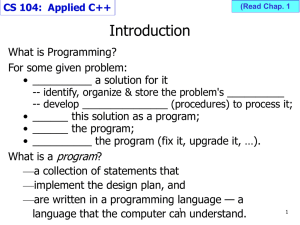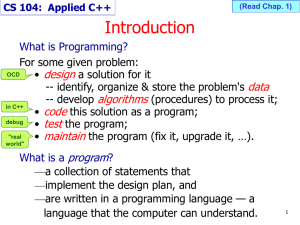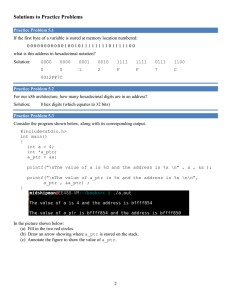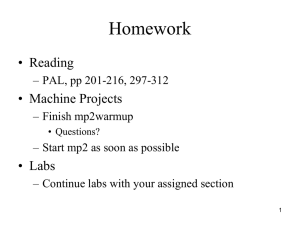Call by Value
advertisement
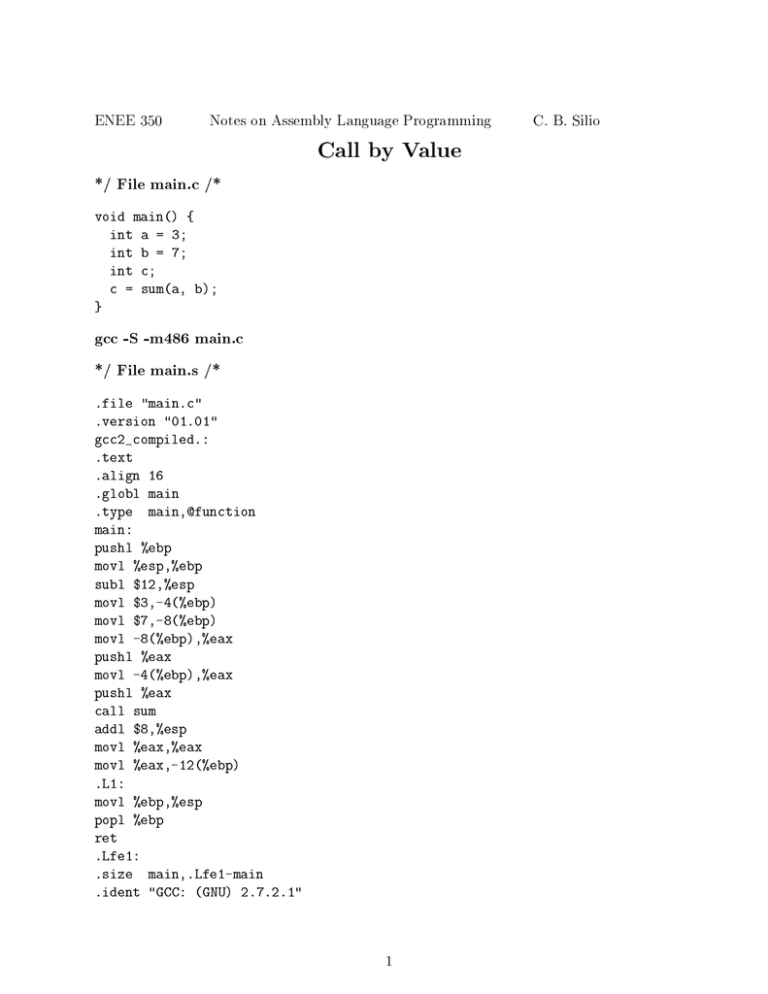
ENEE 350
Notes on Assembly Language Programming
*/ File main.c /*
Call by Value
void main() {
int a = 3;
int b = 7;
int c;
c = sum(a, b);
}
gcc -S -m486 main.c
*/ File main.s /*
.file "main.c"
.version "01.01"
gcc2_compiled.:
.text
.align 16
.globl main
.type main,@function
main:
pushl %ebp
movl %esp,%ebp
subl $12,%esp
movl $3,-4(%ebp)
movl $7,-8(%ebp)
movl -8(%ebp),%eax
pushl %eax
movl -4(%ebp),%eax
pushl %eax
call sum
addl $8,%esp
movl %eax,%eax
movl %eax,-12(%ebp)
.L1:
movl %ebp,%esp
popl %ebp
ret
.Lfe1:
.size main,.Lfe1-main
.ident "GCC: (GNU) 2.7.2.1"
1
C. B. Silio
ENEE 350
Notes on Assembly Language Programming
*/ File sum.c /*
Call by Value Continued
int sum(int x, int y) {
return (x+y);
}
gcc -S -m486 sum.c
*/ File sum.s /*
.file "sum.c"
.version "01.01"
gcc2_compiled.:
.text
.align 16
.globl sum
.type sum,@function
sum:
pushl %ebp
movl %esp,%ebp
movl 8(%ebp),%edx
addl 12(%ebp),%edx
movl %edx,%eax
jmp .L1
.align 16
.L1:
movl %ebp,%esp
popl %ebp
ret
.Lfe1:
.size sum,.Lfe1-sum
.ident "GCC: (GNU) 2.7.2.1"
2
C. B. Silio
ENEE 350
Notes on Assembly Language Programming
*/ File main.c /*
Call by Reference
void main() {
int a = 3;
int b = 7;
int c;
sum(&a, &b, &c);
}
gcc -S -m486 main.c
*/ File main.s /*
.file "main.c"
.version "01.01"
gcc2_compiled.:
.text
.align 16
.globl main
.type main,@function
main:
pushl %ebp
movl %esp,%ebp
subl $12,%esp
movl $3,-4(%ebp)
movl $7,-8(%ebp)
leal -12(%ebp),%eax
pushl %eax
leal -8(%ebp),%eax
pushl %eax
leal -4(%ebp),%eax
pushl %eax
call sum
addl $12,%esp
.L1:
movl %ebp,%esp
popl %ebp
ret
.Lfe1:
.size main,.Lfe1-main
.ident "GCC: (GNU) 2.7.2.1"
3
C. B. Silio
*/ File sum.c /*
Call by Reference Continued
void sum(int *x, int *y, int *z) {
*z = *x + *y;
}
gcc -S -m486 sum.c
*/ File sum.s /*
.file "sum.c"
.version "01.01"
gcc2_compiled.:
.text
.align 16
.globl sum
.type sum,@function
sum:
pushl %ebp
movl %esp,%ebp
pushl %ebx
movl 16(%ebp),%eax
movl 8(%ebp),%edx
movl 12(%ebp),%ecx
movl (%edx),%ebx
addl (%ecx),%ebx
movl %ebx,(%eax)
.L1:
movl -4(%ebp),%ebx
movl %ebp,%esp
popl %ebp
ret
.Lfe1:
.size sum,.Lfe1-sum
.ident "GCC: (GNU) 2.7.2.1"
4
ENEE 350
*/ main.c /*
Notes on Assembly Language Programming
Call by Value for the MAC-1
void main() { int a = 3;
int b = 7;
int c;
C. B. Silio
c = sum(a, b); }
The assumed conventions for the MAC-1 are that values are passed on the stack to the called
function \sum" and that the function returns the value it computes in the accumulator (ac)
register. Also it is assumed that the main program has a starting address specied on the
assembler's END directive and also that it must initialize the stack pointer (sp) register.
/Main Program illustrating call by value (version 1)
EXTRN sum
/Declare label sum to be externally defined
a
3
/Define variables (symbolic addresses) and
b
7
/ their contents
c
RES
1
/Reserve a memory location for the answer
start
loco
4020
/Initialize stack pointer register contents
swap
/ to 4020 (base 10)
begin
loco
b
/Put address b into ac
pshi
/Push value in address b ([b] = 7) onto stack
loco
a
/Put address a into ac
pshi
/Push value in address a ([a] = 3) onto stack
call
sum
/Call addition function; result returns in ac
stod
c
/Put away result in ac into location c
insp
2
/Clear out stack frame; i.e., reset sp to 4020
halt
/Stop execution
END
start
/This main program has starting address start
An alternate way of placing the values on the stack directly is shown below:
/Main Program illustrating call by value (version 2)
EXTRN sum
/Declare label sum to be externally defined
a
3
/Define variables (symbolic addresses) and
b
7
/ their contents
c
RES
1
/Reserve a memory location for the answer
start
loco
4020
/Initialize stack pointer register contents
swap
/ to 4020 (base 10)
begin
lodd
b
/Put value in address b ([b] = 7) into ac
push
/Push it onto the stack
lodd
a
/Put value in address a ([a] = 3) into ac
push
/Push it onto the stack
call
sum
/Call addition function; result returns in ac
stod
c
/Put away result in ac into location c
insp
2
/Clear out stack frame; i.e., reset sp to 4020
halt
/Stop execution
END
start
/This main program has starting address start
5
ENEE 350
*/ sum.c /*
Notes on Assembly Language Programming
C. B. Silio
Call by Value for the MAC-1 Continued
int sum(int x, int y) {return (x+y);}
Note that the variables x and y are sometimes called \dummy variables" because they refer
only to the parameters passed to the function subprogram and not to actual memory locations. x refers to the rst parameter and y refers to the second parameter. Parameters are
sometimes called arguments. The assumed convention is that the parameters are passed on
the stack in the order placed there by the calling program. Upon entry the stack pointer
register (sp) points to the memory location containing the return address (i.e., the program
counter register contents when the call instruction in the calling program was executed).
Thus, the return address is currently in the top of stack location. The second parameter
pushed on the stack is underneath it at location sp+1 and the rst parameter pushed on
the stack is underneath the rst parameter at location sp+2. (Recall that the sp register is
decremented by a push or call and is incremented by a pop or return). Upon entry to the
function subprogram the stack appearss as follows:
sp ---> 4017
4018
4019
4020
----------------|Return address |
----------------|
3
|
----------------|
7
|
----------------|
?
|
-----------------
/Function subprogram sum
ENTRY
sum
/Declare label sum as entry point
x
EQU
1
/Define absolute constant values for
y
EQU
2
/ symbols x and y (not really necessary)
sum
lodl
x
/Pick up first parameter value; ac:=m[sp+1]
addl
y
/Add to ac second parameter value ac:=ac+m[sp+2]
retn
/Leave result in ac register and return
END
Assembly, linking, and execution of the above main program and sum function would be
carried out by the following sequence of statements (assuming that the main program is in
le \prog" and that the function is in le \sub":
tap ee350
assem prog
assem sub
load prog sub
sim prog.abs $EE350/halt $EE350/halt.pascal
tsim prog.abs $EE350/halt $EE350/halt.pascal
6
ENEE 350
Notes on Assembly Language Programming
C. B. Silio
Call by Reference for the MAC-1
*/ main.c /*
void
main() {int a = 3;
int b = 7;
int c;
sum(&a, &b, &c);}
Call by reference passes addresses as parameters to the called procedure. This called procedure is sometimes called a subroutine. FORTRAN distinguishes two types of subprograms:
(1) subroutines, and (2) functions. Furthermore, FORTRAN compilers typically use call by
reference for parameter passing in both types of subprograms. In C everything is a function; however, those declared to be void do not return a value in some register such as the
accumulator register and essentially act like FORTRAN subroutines if call by reference is
used.
/Main Program illustrating call by reference
EXTRN sum
/Declare label sum to be externally defined
a
3
/Define variables (symbolic addresses) and
b
7
/ their contents
c
RES
1
/Reserve a memory location for the answer
start
loco
4020
/Initialize stack pointer register contents
swap
/ to 4020 (base 10)
begin
loco
c
/Put address value c into ac
push
/Push it onto the stack
loco
b
/Put address value b into ac
push
/Push it onto the stack
loco
a
/Put address value a into ac
push
/Push it onto the stack
call
sum
/Call addition function; result returns in ac
insp
3
/Clear out stack frame; i.e., reset sp to 4020
halt
/Stop execution
END
start
/This main program has starting address start
7
ENEE 350
Notes on Assembly Language Programming
C. B. Silio
Call by Reference for the MAC-1 Continued
*/ sum.c /*
void sum(int *x, int *y, int *z) { *z = *x + *y;}
Upon entry to subroutine sum the stack (area of memory) appears as follows:
4014
4015
sp ---> 4016
4017
4018
4019
4020
----------------|
|
----------------|
|
----------------|Return address |
----------------| Address a
|
----------------| Address b
|
----------------| Address c
|
----------------|
?
|
-----------------
/Subroutine sum(*x, *y, *z)
ENTRY
sum
/Declare label sum as entry point
x
EQU
2
/Define absolute constant offset values for
y
EQU
4
/ symbols x and y (not really necessary)
sum
lodl
x
/Pick up first parameter value; address b
pshi
/Push content of address b onto stack; [b]=7
lodl
x
/Pick up second parameter value; address a
pshi
/Push content of address a onto stack; [a]=3
pop
/Get content of address a into ac
addl
0
/Add to ac content of address b; note 0 = zero
stol
0
/Put sum onto stack immediately above ret. addr.
lodl
y
/Get address c into ac
popi
/Pop the resulting sum off the stack into location c
retn
/Return
END
8
